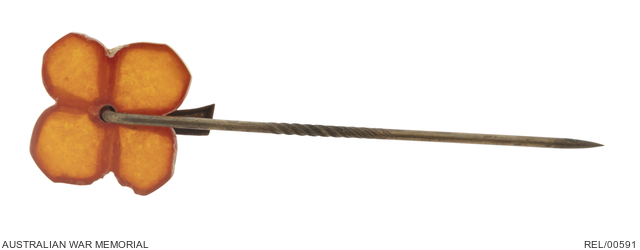| Place | Oceania: Australia, South Australia, Adelaide |
|---|---|
| Accession Number | REL/00591 |
| Collection type | Heraldry |
| Object type | Badge |
| Physical description | Metal |
| Maker |
Unknown |
| Place made | Germany |
| Date made | c 1930s |
| Conflict |
First World War, 1914-1918 |
| Source credit to | This item has been digitised with funding provided by Commonwealth Government. |
German Winterhilfswerk (Winter help work) flower lapel pin: Consul Dr Oscar Seger (enemy alien)






Amber and metal German Winterhilfswerk (Winter help work) flower lapel pin. The amber flower has four distinct petals. Attached through the centre is a metal lapel pin.
This Winterhilfswerk badge was confiscated from the South Australian German Consul Dr Oscar Seger from his Adelaide home at the outbreak of the Second World War. Dr Seger was given a free visa to return to Germany and two days to pack. The contents of his home including rare antique furniture were later auctioned by the Commonwealth government after the war in 1949. Newspaper reports from 1949 record how Dr Seger returned to Germany and had later died in a Russian internment camp. His wife survived the war and was living in Eastern Germany. The proceeds of the 1949 Commonwealth auction were forwarded to her.
The Winterhilfswerk was an annual months-long compulsory charity drive. It was established as early as 1931 by the Heinrich Bruning government, and was adopted and championed by the National Socialist German Workers' Party or Nazi Party as early as 1933. The drive took place through the months of October to May to raise funds for basic needs for the poorest during winter. Food, clothing, coal and other items were handed out by the Nationalsozialistischm Volkswohlfahrt (National Socialist People’s Welfare Organization), whose slogan was 'none shall starve nor freeze'. Various groups including the Hitler Youth went door to door soliciting donations from the public, and in return gift the latest lapel design or booklet. At times the designs would change as often as weekly so that the public were pressured into contributing money frequently by wearing the latest badge. By 1945 over 8000 different badges had been produced, in a variety of material and techniques including wood, glass, paper, metal, plastic, leather and amber. People who were not wearing the latest lapel were publically shamed and their names printed in the newspaper. Community pressure ensured constant giving from the German people.
This item forms part of a large collection of illegal material that was confiscated from enemy aliens and Fascist organisations in Adelaide at the start of the Second World War. This material was held by the Adelaide Attorney-General's Department for the duration of the war. Decades later, effort was made to reunite the confiscated material with its owner where they could be found, with the remaining material acquired by the Memorial.